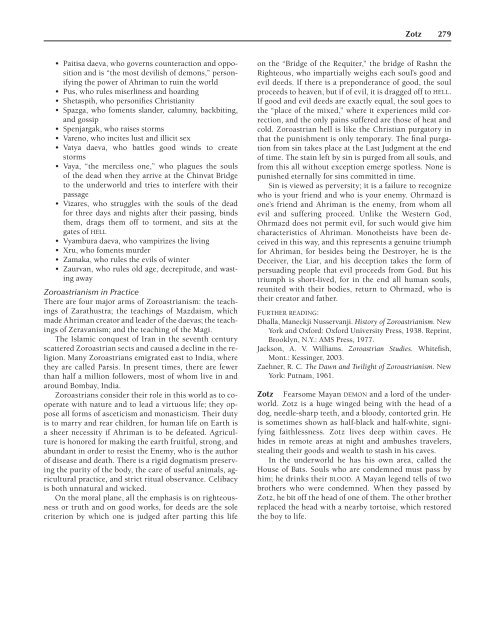The Encyclopedia Of Demons And Demonology
The Encyclopedia Of Demons And Demonology
The Encyclopedia Of Demons And Demonology
You also want an ePaper? Increase the reach of your titles
YUMPU automatically turns print PDFs into web optimized ePapers that Google loves.
Zotz 279<br />
• Paitisa daeva, who governs counteraction and opposition<br />
and is “the most devilish of demons,” personifying<br />
the power of Ahriman to ruin the world<br />
• Pus, who rules miserliness and hoarding<br />
• Shetaspih, who personifies Christianity<br />
• Spazga, who foments slander, calumny, backbiting,<br />
and gossip<br />
• Spenjargak, who raises storms<br />
• Vareno, who incites lust and illicit sex<br />
• Vatya daeva, who battles good winds to create<br />
storms<br />
• Vaya, “the merciless one,” who plagues the souls<br />
of the dead when they arrive at the Chinvat Bridge<br />
to the underworld and tries to interfere with their<br />
passage<br />
• Vizares, who struggles with the souls of the dead<br />
for three days and nights after their passing, binds<br />
them, drags them off to torment, and sits at the<br />
gates of HELL<br />
• Vyambura daeva, who vampirizes the living<br />
• Xru, who foments murder<br />
• Zamaka, who rules the evils of winter<br />
• Zaurvan, who rules old age, decrepitude, and wasting<br />
away<br />
Zoroastrianism in Practice<br />
<strong>The</strong>re are four major arms of Zoroastrianism: the teachings<br />
of Zarathustra; the teachings of Mazdaism, which<br />
made Ahriman creator and leader of the daevas; the teachings<br />
of Zeravanism; and the teaching of the Magi.<br />
<strong>The</strong> Islamic conquest of Iran in the seventh century<br />
scattered Zoroastrian sects and caused a decline in the religion.<br />
Many Zoroastrians emigrated east to India, where<br />
they are called Parsis. In present times, there are fewer<br />
than half a million followers, most of whom live in and<br />
around Bombay, India.<br />
Zoroastrians consider their role in this world as to cooperate<br />
with nature and to lead a virtuous life; they oppose<br />
all forms of asceticism and monasticism. <strong>The</strong>ir duty<br />
is to marry and rear children, for human life on Earth is<br />
a sheer necessity if Ahriman is to be defeated. Agriculture<br />
is honored for making the earth fruitful, strong, and<br />
abundant in order to resist the Enemy, who is the author<br />
of disease and death. <strong>The</strong>re is a rigid dogmatism preserving<br />
the purity of the body, the care of useful animals, agricultural<br />
practice, and strict ritual observance. Celibacy<br />
is both unnatural and wicked.<br />
On the moral plane, all the emphasis is on righteousness<br />
or truth and on good works, for deeds are the sole<br />
criterion by which one is judged after parting this life<br />
on the “Bridge of the Requiter,” the bridge of Rashn the<br />
Righteous, who impartially weighs each soul’s good and<br />
evil deeds. If there is a preponderance of good, the soul<br />
proceeds to heaven, but if of evil, it is dragged off to HELL.<br />
If good and evil deeds are exactly equal, the soul goes to<br />
the “place of the mixed,” where it experiences mild correction,<br />
and the only pains suffered are those of heat and<br />
cold. Zoroastrian hell is like the Christian purgatory in<br />
that the punishment is only temporary. <strong>The</strong> final purgation<br />
from sin takes place at the Last Judgment at the end<br />
of time. <strong>The</strong> stain left by sin is purged from all souls, and<br />
from this all without exception emerge spotless. None is<br />
punished eternally for sins committed in time.<br />
Sin is viewed as perversity; it is a failure to recognize<br />
who is your friend and who is your enemy. Ohrmazd is<br />
one’s friend and Ahriman is the enemy, from whom all<br />
evil and suffering proceed. Unlike the Western God,<br />
Ohrmazd does not permit evil, for such would give him<br />
characteristics of Ahriman. Monotheists have been deceived<br />
in this way, and this represents a genuine triumph<br />
for Ahriman, for besides being the Destroyer, he is the<br />
Deceiver, the Liar, and his deception takes the form of<br />
persuading people that evil proceeds from God. But his<br />
triumph is short-lived, for in the end all human souls,<br />
reunited with their bodies, return to Ohrmazd, who is<br />
their creator and father.<br />
FURTHER READING:<br />
Dhalla, Maneckji Nusservanji. History of Zoroastrianism. New<br />
York and Oxford: Oxford University Press, 1938. Reprint,<br />
Brooklyn, N.Y.: AMS Press, 1977.<br />
Jackson, A. V. Williams. Zoroastrian Studies. Whitefish,<br />
Mont.: Kessinger, 2003.<br />
Zaehner, R. C. <strong>The</strong> Dawn and Twilight of Zoroastrianism. New<br />
York: Putnam, 1961.<br />
Zotz Fearsome Mayan DEMON and a lord of the underworld.<br />
Zotz is a huge winged being with the head of a<br />
dog, needle-sharp teeth, and a bloody, contorted grin. He<br />
is sometimes shown as half-black and half-white, signifying<br />
faithlessness. Zotz lives deep within caves. He<br />
hides in remote areas at night and ambushes travelers,<br />
stealing their goods and wealth to stash in his caves.<br />
In the underworld he has his own area, called the<br />
House of Bats. Souls who are condemned must pass by<br />
him; he drinks their BLOOD. A Mayan legend tells of two<br />
brothers who were condemned. When they passed by<br />
Zotz, he bit off the head of one of them. <strong>The</strong> other brother<br />
replaced the head with a nearby tortoise, which restored<br />
the boy to life.












